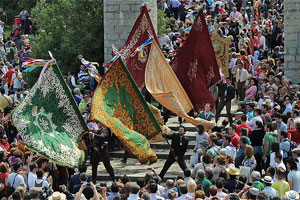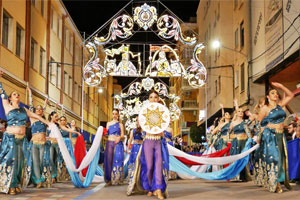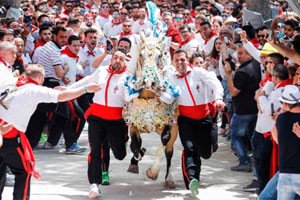Baptism of the Child in Palencia

The city of Palencia becomes the centre of attention every 1st January, thanks to the celebration of the procession known as the Baptism of the Child, a ceremony in which the members of the Brotherhood of the Sweet Name of Jesus rock the Baroque carving of the Child to the sound of the popular carol Ea. The ceremony ends with the Pedrea of sweets and candies.
What awaits you at the Christening of the Child in Palencia?
The feast of the Christening of the Child in Palencia begins in the beautiful Church of San Miguel, located on the banks of the river Carrión, when the members of the Brotherhood of the Sweet Name of the Child Jesus carry the Baroque carving of the Child in procession on their shoulders.
But, this procession has the particularity that they rock the image of the Infant Jesus to the sound of music, at the same time that they sing a well-known carol known as Ea, while they make the route around the church.
As the procession proceeds, candies and sweets are thrown from the balconies in front of the church, to the delight of all those in attendance.
This religious celebration ends with a nocturnal performance of the hymn of Palencia, at the foot of the tower of San Miguel.
Origin of the Baptism of the Child
The origin of this celebration dates back to the 16th century, in the Jewish quarter of Palencia. Something interesting about this religious ceremony, in addition to the fact that the inhabitants have managed to keep the tradition alive, is that they continue to celebrate the Baptism of the Child in the same place where, many years ago, the Jewish quarter in which this procession originated was located.
What else is there to see in Palencia?
Apart from the Church of San Miguel when you attend the procession of the Baptism of the Child, there are other places you can visit in Palencia, a surprising city in Spain, which has the name of Bella Desconocida (Unknown Beauty).
- Christ of the Otero. If you want to enjoy one of the most impressive views of the city, you can climb up to the Cristo del Otero, where you will also see a fantastic statue of Christ standing 20 metres high, undoubtedly one of the tallest in the world.
- Cathedral of San Antolin. Located in the old town, it is one of the most beautiful buildings in the area, perhaps due to the combination of different architectural styles.
- Stroll along the banks of the Carrión. If you prefer to be in contact with nature, this walk along the banks of the Carrión is perfect. You can visit the Huertas del Obispo, the Sotillo de los Canónigos Park and cross the Puente Mayor.
Gastronomy in Palencia
Next January 1st, apart from being part of the beautiful procession of the Baptism of the Child in Palencia, don't hesitate to try these typical dishes from Palencia.
- Lechazo Churro: enjoy the tender and juicy meat of a suckling lamb. It is a suckling lamb of the churra breed, raised with a special diet. It is usually prepared roasted in a clay pot.
- Menestra Palestina: this is a delicious stew, which combines various vegetables with chopped meat, either beef or lamb. It is garnished with pieces of boiled egg, red pepper and asparagus.
- Socorritos: this is a traditional sweet, consisting of a delicious puff pastry with a very soft texture, which is then covered with icing sugar.






